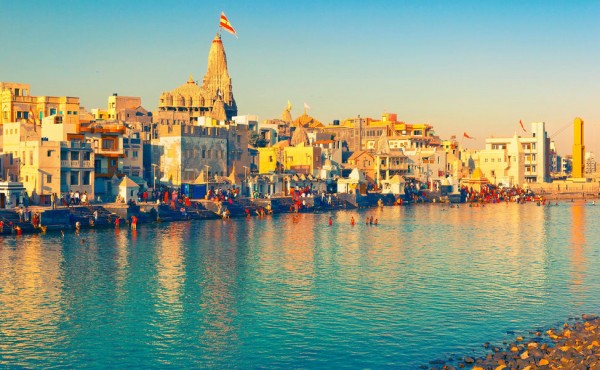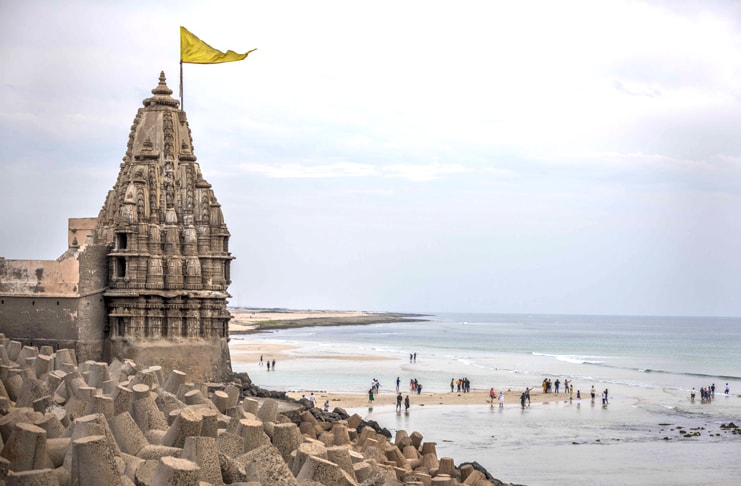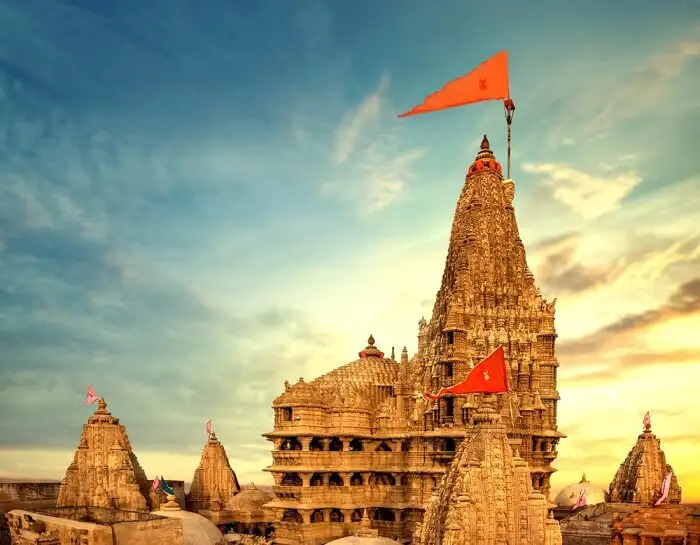


The western Indian coastal city of Dwarka is well-known for having been the former capital of Lord Krishna. It's additionally one of India's holiest cities and a popular travel destination for both tourists and devotees. The city, which is flanked by the Gomti River and the Arabian Sea on both sides, is the location of numerous historic temples, including the well-known Dwarkadheesh temple. With its extensive history and magnificent architecture, the city of Dwarka is a remarkable location. Dwarka has a lot to offer, from the imposing Dwarkadheesh temple to the exquisitely carved castles and monuments. Moreover, the town is home to a number of India's most stunning beaches and provides a wide range of attractions for all guests.
The city is also home to several ancient monuments, such as the Dwarka Fort and the ruins of the Vijaygarh Fort.
The western Indian city of Dwarka is a historic site known for housing the reign of Lord Krishna. It is described in the Mahabharata and Puranas and is thought to have existed as early as the sixth century BCE. The city was founded by the legendary King Anu, and its name was "Dvrak," according to the Mahabharata. The city was rebuilt in the eighth century by Vajranabha, Lord Krishna's great-grandson. The city gained popularity during this time and developed into a significant port, conducting business with nations in the Middle East and Africa. Dwarka was governed by the Mughal Empire in the 16th century, and then the Marathas took over in the 17th century.
Dwarka joined the British Empire in the early 19th century before becoming a part of independent India in 1947. Nowadays, Dwarka is a well-liked pilgrimage site for Hindus and a favorite among visitors thanks to its numerous temples, gorgeous architecture, and vibrantly rich culture.

Airways
Around 137 kilometres distant in Jamnagar is the closest airport. Flights to the airport are frequently available from destinations like Ahmedabad and Mumbai. Taxi services to Dwarka are accessible from the airport.
Railways
An essential rail hub is the Dwarka railway station, which is linked to the Ahmedabad-Okha train line. There are trains that stop at the station from Ahmedabad, Delhi, Mumbai, Kolkata, and Bengaluru.
Roadways
There are numerous roads leading to Dwarka. Buses operated by the state and by private companies travel often to Dwarka from a number of Gujarati cities, including Ahmedabad, Porbandar, Rajkot, Vadodara, Amerli, and many others. One can opt for a private cab facility too.
A temperate climate characterizes Dwarka, with daily highs of about 28 °C (82 °F). The city experiences warm summers with highs of up to 35 °C (95 °F) and mild winters with lows of about 10 °C (50 °F).
The greatest season to visit Dwarka is in the winter, between October and March, when the weather is comfortable and great for sightseeing. Tourists can also engage in the myriad events and celebrations that are held across the city throughout these months.
The goals and interests of each traveler will determine how long they should remain in Dwarka. Two to three days are plenty to visit all of the city's important religious and cultural landmarks. A longer stay of 7 days is advised for those who want to enjoy the city's vibrant culture and festivals.

1. Dwarkadheesh Temple: It is, in fact, the main draw of the visit of the Dwarka temples. This temple, also known as Jagat Mandir, is widely believed to have been constructed by none other than Lord Krishna's grandson Vajranabh.
2. Nageshwar Jyotirlinga: The visit of this temple in Darukavanam, 15 km from the city of Dwarka, which is the first of the 12 "swayambhu" (or self-existing) jyotirlingas dispersed over the world, can be combined with a tour of Beyt Dwarka island. For Shaivites, this is an excellent location for a pilgrimage. The temple complex contains a magnificent sitting deity of Lord Shiva that is 80 feet tall.
3. Swaminarayan Temple: One of the most tranquil locations to visit in Dwarka is this relatively newer gorgeous temple, which is consecrated to Lord Swaminarayan, an embodiment (incarnation) of Lord Vishnu.
4. Sudama Setu: The bridge connects the Panchnad or Panchkui Tirth to its southeast with the Dwarkadheesh temple over the Gomti river. The bridge not only provides access to the island with five sweet water wells (called after the Panch Pandav), or panch kuans, but also fulfills a religious purpose of pilgrimage. The bridge offers amazing views of the Arabian Sea, the Gomti River, and the Dwarkadheesh Temple. It is also traversed by camels and ATV bikes in the winter.
5. Beyt Dwarka & Dunny point: This island is home to coral reefs and white sand beaches. Here, dolphins have also been seen. Some also think that this was Lord Krishna's original, prehistoric home. An ecotourism destination called Dunny Point is located at the triangulated point of Beyt Dwarka and is popular for sunbathing, dolphin viewing, night trekking, and coral exploration. Campers are known to frequent this area.
6. Shivrajpur Beach: This calm beach with a lovely white sand bay edge is located near the village of Shivrajpur. This beach offers breath-taking vistas of the Arabian Sea's azure seas on the route to Beyt Dwarka. At this location, you may watch the oceanic sunsets. The Lighthouse is open to visitors from 4 to 6 p.m.
If you are looking for the best places to stay in Dwarka, then Treebo Trend Jannat Residency, OYO Townhouse 604 The Royal Galaxy, and OYO 61218 Silver Palace are some of the recommended options. The Fern Sattva Resor is a great option if you are looking for a resort in Dwarka. For a hotel, you could consider Dwarkadhish Lords Eco Inn or Hotel Rajdhani, both of which have been highly rated by customers. No matter what you choose, you can be sure of a comfortable and pleasant stay in Dwarka.